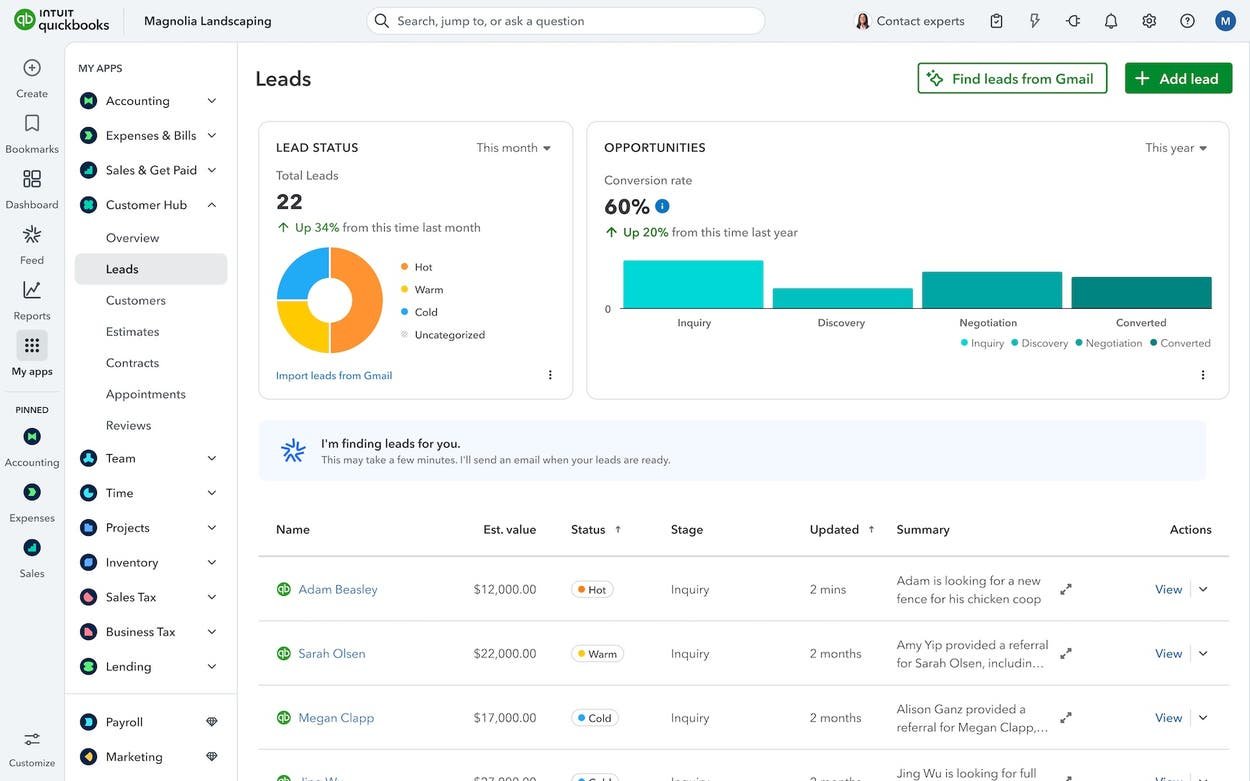Business
Level up your business with Intuit QuickBooks’ AI Agents

Intuit QuickBooks has helped their business customers for over 40 years, providing the resources they need to scale successfully – such as their QuickBooks Capital Loans service. Now with the introduction of their latest AI Agents, those tools are as seamless as ever.
Intuit QuickBooks’ new AI agents provide a number of practical uses across all areas of a business at every stage. From marketing plans, customer servicing and growth strategy, Intuit QuickBooks will have a helping hand for many disciplines.
Even if those AI agents can’t answer tough questions, Intuit QuickBooks’ human experts are available to step in to provide assistance, to make sure users are getting the answers they need.
To celebrate the launch of these new AI assistants, Intuit QuickBooks is offering new customers a special discount on its QuickBooks Online subscriptions – a massive 50 percent off for the first three months, but only for a limited time.
If you want to find out how to get this deal before it ends, visit Intuit QuickBooks’ website to find out more, or if you want to read more about how Intuit QuickBooks’ AI agents can facilitate your business needs, keep reading below.
Customer Agent: Starting from $19 per month for three months, QuickBooks.com
Intuit QuickBooks’ Customer Agent is an AI-powered assistant with a sophisticated level of customer knowledge and insight. The Customer Agent is capable of sourcing new business leads and even drafting personalised email responses as it tracks every customer opportunity in the sales cycle. For those warm leads the Customer Agent can suggest and schedule meetings in advance, all based on engagement data.
For an even greater overview of customer management, Intuit QuickBooks also features a customer hub to help monitor and build those strong relationships. It’s complete with automated feedback collection, contract workflows and lead management, all on a customisable interface.
Marketing Agent: Starting from $19 per month for three months, QuickBooks.com
Expected to be fully implemented later this year, the Marketing Agent will be a useful assistant for budding marketers as they look to build their toolbox and promote their business.
The Marketing Agent will feature powerful tools like automated audience management to track potential customers and speak directly to them. It will also be able to execute marketing campaigns, along with its own content creation platform to give business owners a range of different ways to deliver to audiences with measurable impact.
For loyal and retained customers, the Marketing Agent will also be able to assist in users’ retention marketing campaigns to keep them engaged – all of which can be conducted via Mailchimp.
Business Insights: Starting from $19 per month for three months, QuickBooks.com

As part of the service, Intuit QuickBooks offers a business feed to succinctly summarise work done by AI Agents.
This AI reporting tool can share even more useful insight into the performance of a business, such as P&L statements, balance sheets and more. By utilising all the AI tools it has available, these Business Insights can help inform users on important decisions. Even if users don’t fully agree with the recommendations this tool makes, they are entirely free to disregard them – meaning they are always in control.
Business
AI FOMO, Shadow AI, and Other Business Problems

I have been encountering some interesting news about how the AI industry is progressing. It feels like a slowdown in this space is definitely on the horizon, if it hasn’t already started. (Not being an economist, I won’t say bubble, but there are lots of opinions out there.) GPT-5 came out last month and disappointed everyone, apparently even OpenAI executives. Meta made a very sudden pivot and is reorganizing its entire AI function, ceasing all hiring, immediately after putting apparently unlimited funds into recruiting and wooing talent in the space. Microsoft appears to be slowing their investment in AI hardware (paywall).
This isn’t to say that any of the major players are going to stop investing in AI, of course. The technology isn’t demonstrating spectacular results or approaching anything even remotely like AGI, which many analysts and writers (including me) had predicted it wouldn’t, but there’s still a level of utilization among businesses and individuals that is persisting, so there’s some incentive to keep pushing forward.
The 5% Success Rate
In this vein, I read the new report from MIT about AI in business with great interest this week. I recommend it to anyone who’s looking for actual information about how AI adoption is going from regular workers as well as the C-suite. The report has some headline takeaways, including an assertion that only 5% of AI initiatives in the business setting generate meaningful value, which I can certainly believe. (Also, AI is not actually taking people’s jobs in most industries, and in several industries AI isn’t having much of an impact at all.) A lot of businesses, it seems, have dived into adopting AI without having a strategic plan for what it’s supposed to do, and how that adoption will actually help them achieve their objectives.
I see this a lot, actually — executives who are significantly separated from the day to day work of their organization being gripped by FOMO about AI, deciding AI must become part of their business, but not stepping back and considering how this fits in with the business they already have and the work they already do.
Screwdriver or Magic Wand?
Regular readers will know I’m not arguing AI can’t or shouldn’t be used when it can serve a purpose, of course. Far from it! I build AI-based solutions to business problems at my own organization every day. However, I firmly believe AI is a tool, not magic. It gives us ways to do tasks that are infeasible for human workers and can accelerate the speed of tasks we would otherwise have to do manually. It can make information clearer and help us better understand lengthy documents and texts.
What it doesn’t do, however, is make business success by itself. In order to be part of the 5% and not the 95%, any application of AI needs to be founded on strategic thinking and planning, and most importantly clear-eyed expectations about what AI is capable of and what it isn’t. Small projects that improve particular processes can have huge returns, without having to bet on a massive upheaval or “revolutionizing” of the business, even though they aren’t as glamorous or headline-producing as the hype. The MIT report discusses how vast numbers of projects start as pilots or experimentation but don’t actually come to fruition in production, and I would argue that a lot of this is because either the planning or the clear-eyed expectations were not present.
The authors spend a significant amount of time noting that many AI tools are regarded as inflexible and/or incompatible with existing processes, resulting in failure to adopt among the rank and file. If you build or buy an AI solution that can’t work with your business as it exists today, you’re throwing away your money. Either the solution should have been designed with your business in mind and it wasn’t, meaning a failure of strategic planning, or it can’t be flexible or compatible in the way you need, and AI simply wasn’t the right solution in the first place.
Trading Security for Versatility
On the subject of flexibility, I had an additional thought as I was reading. The MIT authors emphasize that the internal tools that companies offer their teams often “don’t work” in one way or another, but but in reality a lot of the rigidity and limits placed on in-house LLM tools are because of safety and risk prevention. Developers don’t built non-functional tools on purpose, but they have limitations and requirements to comply with. In short, there’s a tradeoff here we can’t avoid: When your LLM is extremely open and has few or no guardrails, it’s going to feel like it lets the user do more, or will answer more questions, because it does just that. But it does that at a significant possible cost, potentially liability, giving false or inappropriate information, or worse.
Of course, regular users are likely not thinking about this angle when they pull up the ChatGPT app on their phone with their personal account during the work day, they’re just trying to get their jobs done. InfoSec communities are rightly alarmed by this kind of thing, which some circles are calling “Shadow AI” instead of shadow IT. The risks from this behavior can be catastrophic — proprietary company data being handed over to an AI solution freely, without oversight, to say nothing of how the output may be used in the company. This problem is really, really hard to solve. Employee education, at all levels of the organization, is an obvious step, but some degree of this shadow AI is likely to persist, and security teams are struggling with this as we speak.
Conclusion
I think this leaves us in an interesting moment. I believe the winners in the AI rat race are going to be those who were thoughtful and careful, applying AI solutions conservatively, and not trying to upturn their model of success that’s worked up to now to chase a new shiny thing. A slow and steady approach can help hedge against risks, including customer backlash against AI, as well as many others.
Before I close, I just want to remind everyone that these attempts to build the equivalent of a palace when a condo would do fine have tangible consequences. We know that Elon Musk is polluting the Memphis suburbs with impunity by running illegal gas generator powered data centers. Data centers are taking up double-digit percentages of all power generated in some US states. Water supplies are being exhausted or polluted by these same data centers that serve AI applications to users. Let’s remember that the choices we make are not abstract, and be conscientious about when we use AI and why. The 95% of failed AI projects weren’t just expensive in terms of time and money spent by businesses — they cost us all something.
Read more of my work at www.stephaniekirmer.com.
Further Reading
https://garymarcus.substack.com/p/gpt-5-overdue-overhyped-and-underwhelming
https://fortune.com/2025/08/18/sam-altman-openai-chatgpt5-launch-data-centers-investments
https://www.theinformation.com/articles/microsoft-scales-back-ambitions-ai-chips-overcome-delays
https://builtin.com/artificial-intelligence/meta-superintelligence-reorg
https://mlq.ai/media/quarterly_decks/v0.1_State_of_AI_in_Business_2025_Report.pdf
https://www.ibm.com/think/topics/shadow-ai
https://futurism.com/elon-musk-memphis-illegal-generators
https://www.visualcapitalist.com/mapped-data-center-electricity-consumption-by-state
https://www.eesi.org/articles/view/data-centers-and-water-consumption
Business
American Eagle’s shares soar as Sydney Sweeney boosts sales

Shares of fashion retailer American Eagle Outfitter have jumped after the company said that its tie-ups with celebrities Sydney Sweeney and Travis Kelce are expected to drive strong sales between July and September.
The US firm’s stocks surged 25% in late trading on Wednesday as American Eagle boss Jay Schottenstein said its second-quarter performance “exceeded expectations“, boosted by the success of its ad campaigns.
American Eagle made headlines with its divisive “Great Jeans” ad for its denim line featuring Sweeney, sparking a debate over race and beauty standards.
The firm also ran a clothing series with athlete Kelce, days after news broke of his engagement to popstar Taylor Swift.
The fall season is off to a positive start, said Mr Schottenstein.
“Fuelled by stronger product offerings and the success of recent marketing campaigns with Sydney Sweeney and Travis Kelce, we have seen an uptick in customer awareness, engagement and comparable sales.”
The Emmy-nominated actress, of Euphoria fame, appears in a jeans advertisement where she says: “Genes are passed down from parents to offspring, often determining traits like hair colour, personality and even eye colour. My jeans are blue.”
The commercial drew intrigue and offence. American Eagle has defended the advert, saying it is referring only to the company’s denim jeans.
The controversy even made it to the White House, with President Donald Trump chiming in to support the actress.
“Sydney Sweeney, a registered Republican, has the HOTTEST ad out there,” he wrote in a Truth Social post on Monday. “Go get ’em Sydney!”
Business
The six things you should do if you’re in a crash

 This Morning
This MorningAs a former police detective, I’ve attended many car accidents but this summer, for the first time, I was in a head-on collision with another car myself.
Being directly involved in one of the more than 900 car accidents that happen in the UK every day gave me a different perspective.
The woman in the other car, in her early seventies, had a medical episode while driving and swerved straight into my lane and hit me.
At the time, I didn’t know any of that – I just remember a huge bang and then everything felt like a blur.
The next thing I knew, two men were at the side of the car trying to get me out. I couldn’t move. I was taken to the hospital for scans but amazingly, I got away with cuts and bruises.
I was very lucky, and the witnesses at the scene were so important because without them, I wouldn’t have understood what had actually happened.
Here are some of the key things I’ve now learnt about what to do in the immediate aftermath of an accident.
 Rebecca Mason
Rebecca Mason1. Be careful what you say
Be mindful of what you say at the scene – both to the other driver and to people around you.
It might feel natural to apologise, even if it’s not your fault, but saying “I’m sorry” can sometimes be taken as an admission of guilt.
2. Stop, check for injuries and call 999
 Rebecca Mason
Rebecca MasonImmediately after an accident, stop your car and turn the engine off – you’re actually committing an offence if you don’t stop after a collision. Then check yourself and your passengers for injuries.
If the cars involved can still move, and the road is clear, try to get your vehicle to a safe place nearby and switch on your hazard lights. If that’s not possible, leave it where it is and stand well back from the traffic.
Call 999 if someone is injured, if the other party drives away or if someone is causing a road block.
3. Exchange contact details
Make sure you exchange details with the other driver. Take down their name, address, contact details and insurance information.
You can also gather contact details from witnesses, as their statements can be critical later.
It’s important to inform your insurer as soon as possible, ideally within 24 hours.
4. Take lots of pictures
 Rebecca Mason
Rebecca MasonIt’s always a good idea to record as much evidence as possible, even if it’s clearly the other party’s fault.
Capture photos of the damage and entire scene.
Stand at a distance to show the full layout, including the position of cars, road signs, weather, skid marks and surroundings.
Also look for CCTV on nearby buildings, shops, or public roads that may have captured the incident.
5. Make notes
Making as many notes as possible is helpful to remember exactly what happened.
Some of the vital details to get down are the time and date of the crash, as well as the registration, make, model and colour of all vehicles involved.
Write down any injuries you or other passengers have sustained.
Anything else you remember such as direction of travel, road name, your speed and any unusual behaviour can also be helpful.
6. Gather dashcam footage
My final piece of advice relates to dashcams, which are incredibly useful.
They provide clear, time-stamped video evidence of what happened in an accident, which can quickly resolve disputes with insurers or the police.
They can also capture dangerous driving or road conditions, helping to protect you from false claims.
Additional reporting by Yasmin Rufo
-

 Business5 days ago
Business5 days agoThe Guardian view on Trump and the Fed: independence is no substitute for accountability | Editorial
-
Tools & Platforms3 weeks ago
Building Trust in Military AI Starts with Opening the Black Box – War on the Rocks
-

 Ethics & Policy1 month ago
Ethics & Policy1 month agoSDAIA Supports Saudi Arabia’s Leadership in Shaping Global AI Ethics, Policy, and Research – وكالة الأنباء السعودية
-

 Events & Conferences4 months ago
Events & Conferences4 months agoJourney to 1000 models: Scaling Instagram’s recommendation system
-

 Jobs & Careers2 months ago
Jobs & Careers2 months agoMumbai-based Perplexity Alternative Has 60k+ Users Without Funding
-

 Education2 months ago
Education2 months agoVEX Robotics launches AI-powered classroom robotics system
-

 Funding & Business2 months ago
Funding & Business2 months agoKayak and Expedia race to build AI travel agents that turn social posts into itineraries
-

 Podcasts & Talks2 months ago
Podcasts & Talks2 months agoHappy 4th of July! 🎆 Made with Veo 3 in Gemini
-

 Podcasts & Talks2 months ago
Podcasts & Talks2 months agoOpenAI 🤝 @teamganassi
-

 Education2 months ago
Education2 months agoAERDF highlights the latest PreK-12 discoveries and inventions


